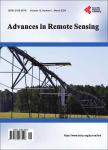Comparative Analysis of the Digital Terrain Models Extracted from Airborne LiDAR Point Clouds Using Different Filtering Approaches in Residential Landscapes
Comparative Analysis of the Digital Terrain Models Extracted from Airborne LiDAR Point Clouds Using Different Filtering Approaches in Residential Landscapes作者机构:Civil Engineering Department Faculty of Engineering Menoufia University Shebin El-Kom Egypt
出 版 物:《Advances in Remote Sensing》 (遥感技术进展(英文))
年 卷 期:2019年第8卷第2期
页 面:51-75页
学科分类:1002[医学-临床医学] 100214[医学-肿瘤学] 10[医学]
主 题:DSM/DEM/DTM Airborne LiDAR Point Clouds DSM Filtering Gaussian Low Pass Filter Focal Analysis Mean Filter DTM Slope-Based Filter Removal of Non-Ground Objects
摘 要:Light Detection And Ranging (LiDAR) is a well-established active remote sensing technology that can provide accurate digital elevation measurements for the terrain and non-ground objects such as vegetations and buildings, etc. Non-ground objects need to be removed for creation of a Digital Terrain Model (DTM) which is a continuous surface representing only ground surface points. This study aimed at comparative analysis of three main filtering approaches for stripping off non-ground objects namely;Gaussian low pass filter, focal analysis mean filter and DTM slope-based filter of varying window sizes in creation of a reliable DTM from airborne LiDAR point clouds. A sample of LiDAR data provided by the ISPRS WG III/4 captured at Vaihingen in Germany over a pure residential area has been used in the analysis. Visual analysis has indicated that Gaussian low pass filter has given blurred DTMs of attenuated high-frequency objects and emphasized low-frequency objects while it has achieved improved removal of non-ground object at larger window sizes. Focal analysis mean filter has shown better removal of nonground objects compared to Gaussian low pass filter especially at large window sizes where details of non-ground objects almost have diminished in the DTMs from window sizes of 25 × 25 and greater. DTM slope-based filter has created bare earth models that have been full of gabs at the positions of the non-ground objects where the sizes and numbers of that gabs have increased with increasing the window sizes of filter. Those gaps have been closed through exploitation of the spline interpolation method in order to get continuous surface representing bare earth landscape. Comparative analysis has shown that the minimum elevations of the DTMs increase with increasing the filter widow sizes till 21 × 21 and 31 × 31 for the Gaussian low pass filter and the focal analysis mean filter respectively. On the other hand, the DTM slope-based filter has kept the minimum elevation of th



